new york city
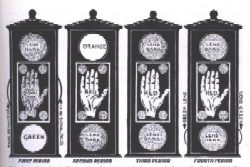 New York City is known for its jaywalking. It may not be the jaywalking capitol of the world, but it has been know to have many jaywalking deaths. That situation inspired the city to install the first walk/don’t walk signs in history on February 5, 1952. Not every inspiration or invention brings change for the better, and I don’t think that all regulation is a good thing, but when it comes to a meeting between a car and a pedestrian, the pedestrian will lose every time. The use of these pedestrian traffic signs are still used today in order to make streets safer.
New York City is known for its jaywalking. It may not be the jaywalking capitol of the world, but it has been know to have many jaywalking deaths. That situation inspired the city to install the first walk/don’t walk signs in history on February 5, 1952. Not every inspiration or invention brings change for the better, and I don’t think that all regulation is a good thing, but when it comes to a meeting between a car and a pedestrian, the pedestrian will lose every time. The use of these pedestrian traffic signs are still used today in order to make streets safer.
Walk/Don’t Walk signs are just a normal fixture these days. We use them at every busy intersection, and don’t give them a second thought…unless they seem to be taking too long to change. Then we feel annoyed, or even cross against the light, which is still jaywalking, even though we are at a crosswalk. While it isn’t uncommon to be annoyed at the wait to cross the street, it can be nice to have that assistance when there is a lot of traffic.
The walk/don’t walk signs have changed over the years, from the very basic style installed in New York City in 1952, to the more modern ones that tell you when to walk or to wait. These are of course designed with the visually impaired person in mind. Our society have become more aware of the needs of the handicapped, and the voice control feature is truly vital.
Strangely, the Walk/Don’t Walk sign has not always been an apostrophe in the word “don’t.” When the first don’t walk signs were installed in New York, they didn’t have an apostrophe between the letters n and t, which makes that the sign was written as ‘dont walk’. It is thought that these signs lack an apostrophe, because it made the stop command more urgent. Another theory about why the signs missed the apostrophe was because 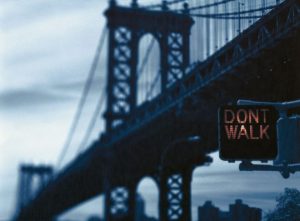 they were made from a single-piece neon light, which made it difficult to add the apostrophe. I don’t suppose we will ever know why, for sure.
they were made from a single-piece neon light, which made it difficult to add the apostrophe. I don’t suppose we will ever know why, for sure.
Between 1999 and 2000, it was decided that the traditional ‘walk’ and ‘don’t walk’ signs should be phased out, because they were difficult to understand for people who didn’t speak English. Many pedestrian accidents occurred with tourists in New York and therefore the city decided to change the traditional sign into a simple stick figure of a walking man when green, and a raised hand when red. Whichever type of walk/don’t walk signs you have in your town, you can be sure that the signs have saved lives.
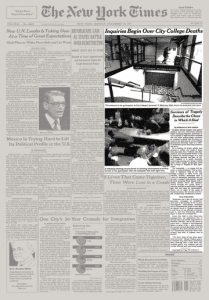 There are many ways to get hurt, but one of the most dangerous is the stampede. Caused by people pushing the people in front of them. It can lead to serious crush injuries. In December of 1991, at a City College gymnasium in New York, New York, a benefit basketball game was being held to benefit AIDS education. In a zealous attempt to bring in as much money as possible, the facility was jammed with as many as 2,000 people over capacity. To make matters worse, a group of gate-crashers tried to push their way into the already overcrowded gymnasium. Thus sparked a stampede that crushed hundreds of ticketholders at the bottom of a basement staircase. Most of the injuries happened near the door to an underground gym that was packed with thousands of spectators.
There are many ways to get hurt, but one of the most dangerous is the stampede. Caused by people pushing the people in front of them. It can lead to serious crush injuries. In December of 1991, at a City College gymnasium in New York, New York, a benefit basketball game was being held to benefit AIDS education. In a zealous attempt to bring in as much money as possible, the facility was jammed with as many as 2,000 people over capacity. To make matters worse, a group of gate-crashers tried to push their way into the already overcrowded gymnasium. Thus sparked a stampede that crushed hundreds of ticketholders at the bottom of a basement staircase. Most of the injuries happened near the door to an underground gym that was packed with thousands of spectators.
The problem with this type of situation is the the people in front get pressed tightly between a wall, and the people behind them. Chief medical examiner, Charles Hirsch said, “the eight people killed all were asphyxiated…squeezed front to back…in the stairwell.” The victims included three women and five men and ranged in age from 16 to 28…Sonia Williams 20, Leonard Nelson 17, Dirk Swain 20, Charise Noel, Jubal Rainey 15, Yul Dargan 24, and Darren Brown 29, were among the dead. Videotape shot from the bleachers revealed a seriously overcrowded gymnasium…at least 2,000 people more than its legal capacity of 2,730 and that tickets were still being sold at the door. “It was oversold,” said Mayor David Dinkins.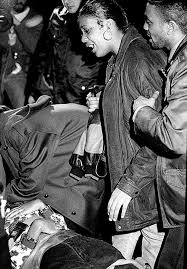
The stampede pushed most of the victims down the stairs, squeezed them through a doorway and onto the gym floor. They tripped and fell over others waiting there, only to be crushed themselves by the next human wave. “It was a cone effect,” said ambulance worker Sy Collins. “The door opens and there were bodies on the floor and people were just running over them.” Bodies piled up as many as six high. The 29 people who sustained crushing injuries included five Emergency Medical Service staffers, some of whom were mauled as the crowd fought over their services.
According to authorities and witnesses, by late afternoon thousands of people had lined up outside the City College gym in upper Manhattan for what was billed as the “Heavy D and Puff Daddy Celebrity Charity Basketball Game” to benefit AIDS education. The teams were to be captained by Heavy D and Puff Daddy, both rap stars. A recorded telephone message told callers that all of the $12 advance tickets had been sold, but that tickets could be bought at the door for $20. Chief of Patrol Mario Salvaggi said the school’s security director called the police before the game and asked for help because the event was sold out. Police who arrived at 5:00 p.m. found a crowd of between 500 and 700 were milling around outside on Convent Avenue. The game was scheduled to start at 6:00 p.m., and the doors opened at 5:00 p.m. Ticketholders passed through a glass door at street level, walked down a 12 foot wide staircase, and passed through a single metal door into the 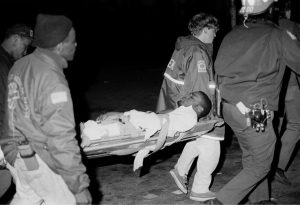 gym. By 7:00 p.m., the game still had not started, and people out on the street began pushing to get inside. A locked glass door was smashed, and people rushed into the gym building. Randy Jones, 30, of the Bronx who was standing inside the door to the gym, said that a woman collecting money at the door got up, took a can holding the night’s receipts, ran into the gym and closed the metal doors behind her, leaving the crowd up in the stairwell. Eventually event organizers began letting people from the stairwell into the gym, but only a few at a time, Jones said. Finally people from the stairs began streaming into the gym, colliding with scores standing inside the door. Soon the floor was covered with injured people.
gym. By 7:00 p.m., the game still had not started, and people out on the street began pushing to get inside. A locked glass door was smashed, and people rushed into the gym building. Randy Jones, 30, of the Bronx who was standing inside the door to the gym, said that a woman collecting money at the door got up, took a can holding the night’s receipts, ran into the gym and closed the metal doors behind her, leaving the crowd up in the stairwell. Eventually event organizers began letting people from the stairwell into the gym, but only a few at a time, Jones said. Finally people from the stairs began streaming into the gym, colliding with scores standing inside the door. Soon the floor was covered with injured people.
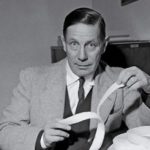 The inspiration for inventions comes from many different sources, and things we would never think could turn into something great, can surprise you. Swiss electrical engineer, George De Mestral had gone for a walk in the woods with his dog, When they got back, De Mestral found himself fascinated with the cockleburs that he had to pull off of his dog. After taking a walk in the woods with his dog, was fascinated by the cockleburs’ ability to cling to his clothes and his dog’s fur. For many dog owners cockleburs are a good reason to grumble. When their pets play outside and return with all sorts of nature stuck to their fur and feet, bringing the outside environment into their once-clean homes, people get annoyed. Nevertheless, not everyone saw this as a big problem.
The inspiration for inventions comes from many different sources, and things we would never think could turn into something great, can surprise you. Swiss electrical engineer, George De Mestral had gone for a walk in the woods with his dog, When they got back, De Mestral found himself fascinated with the cockleburs that he had to pull off of his dog. After taking a walk in the woods with his dog, was fascinated by the cockleburs’ ability to cling to his clothes and his dog’s fur. For many dog owners cockleburs are a good reason to grumble. When their pets play outside and return with all sorts of nature stuck to their fur and feet, bringing the outside environment into their once-clean homes, people get annoyed. Nevertheless, not everyone saw this as a big problem.
When De Mestral looked at the cockleburs under a microscope, he saw the tons of tiny hooks that line cockleburs and discovered they could easily attach to the small loops found in clothing and fur. De Mestral saw this as a opportunity to invent something useful. He experimented with different materials to make his own hooks and loops form a stronger bond. In 1955, after much trial and error, De Mestral decided nylon was perfect and thus Velcro was invented. These days, Velcro is a vital part of everyday life. We use it all the time, and give no thought to life without it.
The word Velcro is a combination of the words “velvet” and “crochet,” and was showcased in a 1959 fashion 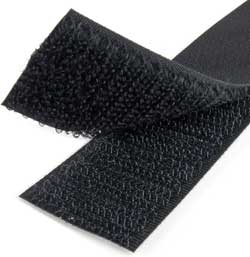 show held at the Waldorf-Astoria Hotel in New York City. However, it didn’t receive positive reviews from fashion enthusiasts. I’m sure they thought it would snag material, and pull hair, which it can do, but its positive uses far outweigh its negative issues. Nevertheless, Velcro wasn’t widely used until NASA made it popular in the early 1960s. Apollo astronauts used it to secure items that they didn’t want escaping in their zero-gravity environment. Hospitals and athletic companies eventually used Velcro after realizing the practicality of the material. In 1968, Puma was the first to use Velcro on shoes. Adidas, Reebok, and others followed suit. Today it is used in many things, including the blood pressure cuff. it has simplified our lives immensely, and to think that it was invented by accident.
show held at the Waldorf-Astoria Hotel in New York City. However, it didn’t receive positive reviews from fashion enthusiasts. I’m sure they thought it would snag material, and pull hair, which it can do, but its positive uses far outweigh its negative issues. Nevertheless, Velcro wasn’t widely used until NASA made it popular in the early 1960s. Apollo astronauts used it to secure items that they didn’t want escaping in their zero-gravity environment. Hospitals and athletic companies eventually used Velcro after realizing the practicality of the material. In 1968, Puma was the first to use Velcro on shoes. Adidas, Reebok, and others followed suit. Today it is used in many things, including the blood pressure cuff. it has simplified our lives immensely, and to think that it was invented by accident.
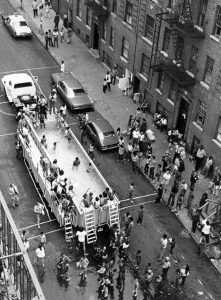 New York City can get hot in the summer. Maybe that is an understatement. I don’t think that New York City has more heat waves than other places, but because of so much asphalt, the heat is in the air, and then radiates back up from the streets again and again. Heat waves like this can not only make people sick, but they can kill people as well. Sometimes, desperate times bring desperate measures. Bathhouses, beaches, community pools, floating pools docked off the East River, all in an effort to cool off the overheated people. Nobody can say that New York City made no effort over the years to keep residents cool on hot summer days, but what of those who couldn’t get to the places set up too cool the the people off. Something had to be done. Enter the Swimmobile.
New York City can get hot in the summer. Maybe that is an understatement. I don’t think that New York City has more heat waves than other places, but because of so much asphalt, the heat is in the air, and then radiates back up from the streets again and again. Heat waves like this can not only make people sick, but they can kill people as well. Sometimes, desperate times bring desperate measures. Bathhouses, beaches, community pools, floating pools docked off the East River, all in an effort to cool off the overheated people. Nobody can say that New York City made no effort over the years to keep residents cool on hot summer days, but what of those who couldn’t get to the places set up too cool the the people off. Something had to be done. Enter the Swimmobile.
In the crisis, New York City decided to bring the pool to the people. These were the Swimmobile pools. They were attached to a truck, which could be parked on a street all day and conveniently towed away at night. “Swimmobiles began during the Heckscher administration [1960s-1970s] that literally took pools to the streets to underserved areas,” says the Parks Department website. It was more that trying to give more people the right to go swimming…this was life and death. A 1976 New York Times article stated that the city owned five mobile pools, which were towed from Randall’s Island to different corners of the city. These Swimmobiles Probably saved countless lives, and the people had fun too.
These past couple of days have brought temperatures in the high 90s and low 100s to Casper, Wyoming, where  I live, and were it not for air conditioning, I would most likely be screaming for a Swimmobile myself, but I’m quite certain, none would be found. These were something that served its purpose in a time of need, and then went the way of most things when technology advances things…into the past. These days, when we are hit with a heatwave, people drive to the pools, lakes, or rivers…or they simply turn on the air conditioner, or if there happens to be an ice cream truck in the area, we can always indulge in some cold treats, as a way to cool off. Of course, if there is a power blackout, they would have to come up with another solution, as ice cream would not hold out long. Thankfully, outages don’t last too long, most of the time, or we might have to bring back the Swimmobile.
I live, and were it not for air conditioning, I would most likely be screaming for a Swimmobile myself, but I’m quite certain, none would be found. These were something that served its purpose in a time of need, and then went the way of most things when technology advances things…into the past. These days, when we are hit with a heatwave, people drive to the pools, lakes, or rivers…or they simply turn on the air conditioner, or if there happens to be an ice cream truck in the area, we can always indulge in some cold treats, as a way to cool off. Of course, if there is a power blackout, they would have to come up with another solution, as ice cream would not hold out long. Thankfully, outages don’t last too long, most of the time, or we might have to bring back the Swimmobile.
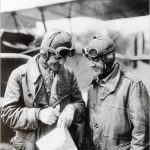 Since people began moving around the world there was a need for mail service, but people hated to wait months to hear from their loved ones…especially if it was with bad news. There had to be a way to get he mail faster and with the invention of the airplane, in late 1903, the possibility of a new way to deliver the mail was on the horizon. It really didn’t take very long for someone to make the metal leap from driving the mail to flying the mail from place to place. Where there is a need, there must be a solution. That solution came on May 15, 1918, when the United States officially established airmail service between New York and Washington DC, using Army aircraft and pilots. Prior to this date, the Post Office Department used new transportation systems such as railroads or steamboats to transport mail. They contracted with the owners of the lines to carry the mail. There were no commercial airlines to contract with, so no one had thought about that yet, but that was about to change.
Since people began moving around the world there was a need for mail service, but people hated to wait months to hear from their loved ones…especially if it was with bad news. There had to be a way to get he mail faster and with the invention of the airplane, in late 1903, the possibility of a new way to deliver the mail was on the horizon. It really didn’t take very long for someone to make the metal leap from driving the mail to flying the mail from place to place. Where there is a need, there must be a solution. That solution came on May 15, 1918, when the United States officially established airmail service between New York and Washington DC, using Army aircraft and pilots. Prior to this date, the Post Office Department used new transportation systems such as railroads or steamboats to transport mail. They contracted with the owners of the lines to carry the mail. There were no commercial airlines to contract with, so no one had thought about that yet, but that was about to change.
Army Major Reuben H. Fleet was charged with setting up the first US airmail service, scheduled to operate beginning May 15, 1918 between Washington DC, Philadelphia, Pennsylvania, and New York City. The army pilots chosen to fly that day were Lieutenants Howard Culver, Torrey Webb, Walter Miller and Stephen Bonsal, all chosen by Major Fleet, and Lieutenants James Edgerton and George Boyle, both chosen by postal officials. Edgerton and Boyle had only recently graduated from the flight school at Ellington Field, Texas and neither had more than 60 hours of piloting time. While I’m sure they were a bit nervous, I’m also sure they were excited to be standing on the threshold of history.
The project got off to a bit of an embarrassingly rocky start, when Lieutenant Boyle, who was engaged to the daughter of Interstate Commerce Commissioner Charles McChord, was selected to pilot the first plane out of Washington DC that day. After all his preparations, Boyle hopped into his plane and was unable to start it. The plane had not been fueled. I’m sure that added a bit of nervousness to the situation. Nevertheless, he finally got his Curtiss Jenny, loaded with 124 pounds of airmail, into the air and made his way to Washington DC. His assignment was to fly to Philadelphia, the mid-way stop between the Washington and New York ends of the service. He did not make it there that day. The novice pilot got lost and low on gas, crash landed in rural Maryland, less than 25 miles away from Washington.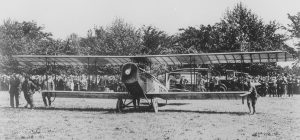
Fortunately for the service, the other flights operated as scheduled that day. Thanks to his political connections, Lieutenant Boyle was given a second chance to fly the airmail out of Washington DC. This time, he was given an escort who flew him out of the city, having given him directions to “follow the Chesapeake Bay” towards Philadelphia. Unfortunately, Boyle followed those instructions too literally, following the curve of the bay over to Maryland’s eastern shore, where he landed, out of fuel again. Not even Boyle’s connections could help him now, and he was removed from the pilots list for the service. I’m sure that didn’t help his standing with his future father-in-law either.
The other rookie pilot, Lieutenant James Edgerton, did much better on his flights and stayed with the service. Edgerton managed to keep his plane aloft during a violent storm that struck while he was on another flight, even as the propeller was pelted by hail. He stayed with the mail service until the next year, and became the Chief of Flying Operations. Then in August, the Post Office Department took over airmail operations with airplanes and civilian pilots of its own. Captain Benjamin Lipsner was named the first superintendent of the U.S. Airmail Service.
The first flight operated by the Post Office Department took off from College Park, Maryland, on August 12, 1918. The destination was New York. Max Miller flew that historic flight. Miller flew the new Curtiss R-4 aircraft. These new planes had more powerful Liberty 400 horsepower engines. Miller was the first pilot hired by the Post Office Department. He died when his plane caught fire and crashed on September 1, 1920. The Post Office Department decided to launch pathfinding flights from New York to Chicago in September 1918. A major obstacle was the Allegheny Mountains, considered by some to be the most dangerous territory on the route. U.S. Airmail Service Superintendent Benjamin Lipsner chose two of his best pilots, Eddie Gardner and Max Miller, for these flights. Eager competitors, Gardner and Miller turned the test into a race. On September 5, 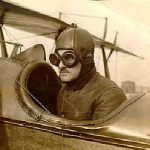 1918, the pair left New York. Miller flew in a Standard airmail plane with a 150-horsepower Hispano-Suiza engine. Gardner followed in a Curtiss R-4 with a 400-horsepower Liberty engine and was accompanied by Eddie Radel, a mechanic. As each pilot landed to refuel or make repairs, he eagerly called Lipsner in Chicago to find out where the other one was. A set of telegrams now in the National Postal Museum tracked their progress. Miller landed in Chicago first, at 6:55 p.m. on September 6. Gardner arrived the next morning, landing at 8:17 at Grant Park. Sometimes it isn’t about the size of the engine I guess. Of course, today, very few people use the postal service, not called “snail mail.” With the internet and texting we have almost instant access to our loved ones.
1918, the pair left New York. Miller flew in a Standard airmail plane with a 150-horsepower Hispano-Suiza engine. Gardner followed in a Curtiss R-4 with a 400-horsepower Liberty engine and was accompanied by Eddie Radel, a mechanic. As each pilot landed to refuel or make repairs, he eagerly called Lipsner in Chicago to find out where the other one was. A set of telegrams now in the National Postal Museum tracked their progress. Miller landed in Chicago first, at 6:55 p.m. on September 6. Gardner arrived the next morning, landing at 8:17 at Grant Park. Sometimes it isn’t about the size of the engine I guess. Of course, today, very few people use the postal service, not called “snail mail.” With the internet and texting we have almost instant access to our loved ones.
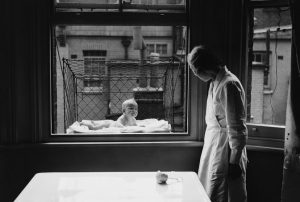 For a long time, people in the 19th century, living in urban apartments, didn’t regularly take their children outside so they could get some fresh air. Then, the doctors started to recommend that these children really needed to get outside for fresh air. Now that doesn’t necessarily mean that the parents were real excited about the idea of loading up their child and taking them for a walk…just to get the recommended amount of fresh air. Nevertheless, it was important, as the doctors told them that it would strengthen their immune system, and with the number of pandemics that had gone around, the parents really tried to do whatever they could to make this happen.
For a long time, people in the 19th century, living in urban apartments, didn’t regularly take their children outside so they could get some fresh air. Then, the doctors started to recommend that these children really needed to get outside for fresh air. Now that doesn’t necessarily mean that the parents were real excited about the idea of loading up their child and taking them for a walk…just to get the recommended amount of fresh air. Nevertheless, it was important, as the doctors told them that it would strengthen their immune system, and with the number of pandemics that had gone around, the parents really tried to do whatever they could to make this happen.
While physicians such as Dr. Luther Emmett Holt advised simply placing an infant’s basket near an open window, some parents took it a step further. Enter the Baby Cage. The baby cage was just what it sounded like. It was a platform, with chicken wire all around it to keep the baby in. This whole contraption was then suspended outside the window…even if the window was on the sixth floor or something. 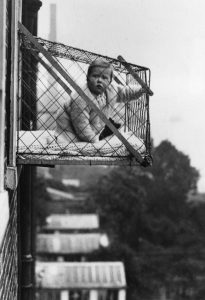 Personally, I can’t imagine hanging my baby outside my window for a dose of fresh air, but it was an actual thing in those days.
Personally, I can’t imagine hanging my baby outside my window for a dose of fresh air, but it was an actual thing in those days.
Eleanor Roosevelt, who by her own admission “knew absolutely nothing about handling or feeding a baby,” bought a chicken-wire cage after the birth of her daughter, Anna. She hung it out the window of her New York City apartment and placed Anna inside for her naps…until a concerned neighbor threatened to report her to the authorities. I would think so. If the brackets that suspended the cage to the window came loose…so long baby. I couldn’t find any incidence of such a thing happening, however. The first commercial patent for a baby cage was filed in 1922 by Emma Read of Spokane, Washington. The cages became popular in London in the 1930s among apartment dwellers without access to backyards. Ultimately, their popularity declined. It is possible that this was connected to safety concerns. As I said, I can imagine. I would have nightmares about that if it were my child.
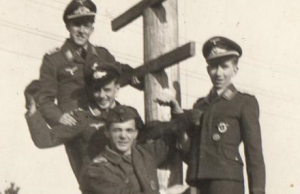 New York City…a place as glamorous as any city in the world, the financial center of the world…and a target. Most of us know about the attacks on the World Trade Center in 1993, and again on September 11, 2001, but there was another attack that was planned for New York City, and in the end…foiled. This attack is most likely one you don’t recall…in fact, I think very few people even knew about it. The United States has enemies, as most nations do, and one of the best know enemies of the United States was Adolf Hitler.
New York City…a place as glamorous as any city in the world, the financial center of the world…and a target. Most of us know about the attacks on the World Trade Center in 1993, and again on September 11, 2001, but there was another attack that was planned for New York City, and in the end…foiled. This attack is most likely one you don’t recall…in fact, I think very few people even knew about it. The United States has enemies, as most nations do, and one of the best know enemies of the United States was Adolf Hitler.
According to an article I read recently, two men. Laureano Clavero and Pere Cardona, interviewed a Nazi pilot from World War II, who passed away in 2013. According to their research and their interview, the two claimed that they had proven the planned attack was real in an interview as they promoted their new book, The Diary of Peter Brill, a Nazi pilot during World War Two. In the interview, Peter Brill, who has been dubbed The Last Luftwaffe Pilot, claimed that Hitler was developing a plan to send a huge bomber from Germany to the United States. The New York mission has long been considered a myth, but Clavero and Cardona insist Brill admitted his involvement when they interviewed him. They claimed that Brill was a part of the secret project.
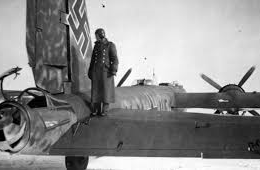
Clavero came across Brill and his history in 2010, when he was investigating the crash of two German bombers in the Pyrenees during the conflict. I’m always amazed at how often looking for one piece of information leads to another discovery. Brill agreed to give the authors an interview, and told them that he had been asked to take part in a secret mission to cross the Atlantic and launch the huge bombardment. While Brill was not specific, the two authors believe the project was convened in 1943, with Hitler’s enthusiastic support. The huge Heinkel plane was to be modified to allow it to fly 12,000 miles…the distance from Berlin to New York and back.
Brill and five others received top-secret training in the Polish city of Thorn, where they learned to fly at high altitude. They had to brave the frequent fires in the bomber’s engines. Before long, it became clear that the Heinkel was incapable of flying to New York and back. The authors claim that, when it became clear that the “Junker” could not fly such a long distance, the German engineers toyed with various workarounds, including 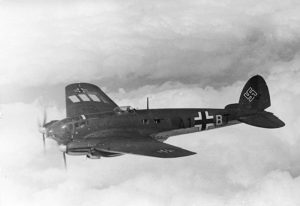 the creation of a halfway house and the coupling of the bomber to a Mescherschmitt. Nevertheless, it soon became clear to everyone that the mission would have to be scrapped, as there were more pressing difficulties taking precedence. “What is certain is that they were close to realizing their objective, but all the crazy dreams of Hitler were left to one side after the battle of Stalingrad,” Cardona said. “They were pushed aside for the day-to-day problems.” Clavero and Cardona have written their new book using the interviews given by Brill, and the memoirs gifted to them by his family when he died. The book sounds very interesting, and I, for one, plan to read about this…almost attack on New York City.
the creation of a halfway house and the coupling of the bomber to a Mescherschmitt. Nevertheless, it soon became clear to everyone that the mission would have to be scrapped, as there were more pressing difficulties taking precedence. “What is certain is that they were close to realizing their objective, but all the crazy dreams of Hitler were left to one side after the battle of Stalingrad,” Cardona said. “They were pushed aside for the day-to-day problems.” Clavero and Cardona have written their new book using the interviews given by Brill, and the memoirs gifted to them by his family when he died. The book sounds very interesting, and I, for one, plan to read about this…almost attack on New York City.

 My nephew, Shannon Moore, who is married to my niece Lindsay, is the Special Teams Coordinator and Tight Ends coach at East Carolina University…Home of the Pirates. Shannon is totally in his element as a coach, having come from the Wyoming Cavalry team, where he and Lindsay met; to Brookings, South Dakota; to Miami, Florida; to Greenville, North Carolina, where he is today. Every move he has made has been a move up in status. For Shannon, Greenville is a personal favorite place. The town is a real football town, and game day is lots of fun. As the coach, it’s like a big celebration, and he gets to be right there in the middle of it all. Shannon thrives on all things football, and I’m quite sure all of the other sports as well.
My nephew, Shannon Moore, who is married to my niece Lindsay, is the Special Teams Coordinator and Tight Ends coach at East Carolina University…Home of the Pirates. Shannon is totally in his element as a coach, having come from the Wyoming Cavalry team, where he and Lindsay met; to Brookings, South Dakota; to Miami, Florida; to Greenville, North Carolina, where he is today. Every move he has made has been a move up in status. For Shannon, Greenville is a personal favorite place. The town is a real football town, and game day is lots of fun. As the coach, it’s like a big celebration, and he gets to be right there in the middle of it all. Shannon thrives on all things football, and I’m quite sure all of the other sports as well.
The cool thing for Shannon and Lindsay is the fact that he has the summers off. They have been spending the summer taking trips here and there. This year, they did a tour of the Northeast. The trip started out in Niagara Falls for Independence Day. Now, I think that would be a very cool place to be for the holiday. Shannon and Lindsay rode on the Maid of the Mist ferry boat to the base of the falls, which is an amazing ride. From Niagara Falls, their trip took them to Portland, Maine. Then they went to New Hampshire and Massachusetts, where 
 they went to the Baseball Hall of Fame. The next leg of their trip took them to Vermont for a nice dinner. And what tour of the Northeast would be complete without a trip to New York City. They went to the Statue of Liberty, Ellis island, and the Brooklyn bridge, as well as taking in a Yankees game. They had been there before, but it was right after Hurricane Sandy, so they were unable to go to those places. They also toured the sites for Seinfeld and You’ve Got Mail. Lindsay tells me that it was “waaaay fun!!” The next leg of their trip was a ride on the Amtrak to Philadelphia to see a Phillies Game, the Liberty Bell and the Rocky Statue. Finally they took the Amtrak back to North Carolina. Their grand tour of the Northeast took them on a plane, train, automobile, and ferry. Lindsay and Shannon have set a goal to see all 50 states. In the Northeast, they have seven states left. They only check off the states, when both of them have been to the state.
they went to the Baseball Hall of Fame. The next leg of their trip took them to Vermont for a nice dinner. And what tour of the Northeast would be complete without a trip to New York City. They went to the Statue of Liberty, Ellis island, and the Brooklyn bridge, as well as taking in a Yankees game. They had been there before, but it was right after Hurricane Sandy, so they were unable to go to those places. They also toured the sites for Seinfeld and You’ve Got Mail. Lindsay tells me that it was “waaaay fun!!” The next leg of their trip was a ride on the Amtrak to Philadelphia to see a Phillies Game, the Liberty Bell and the Rocky Statue. Finally they took the Amtrak back to North Carolina. Their grand tour of the Northeast took them on a plane, train, automobile, and ferry. Lindsay and Shannon have set a goal to see all 50 states. In the Northeast, they have seven states left. They only check off the states, when both of them have been to the state.
As if the summer hasn’t been busy enough, Shannon has also been keeping himself busy with golfing and yard work. They will try to get to the beach a few times before fall, and they did make a trip back home to Wyoming 
 for a visit, stopping to see Shannon’s folks too along the way. I think it’s been a long time since they have driven back to Wyoming. Lindsay was kind of amazed that it took three days to drive home. In the fall, it will be back too football training again. Lindsay is so cute. Every time I ask her for information, she always adds one little thing, this time she said, “Oh yeah AND I know I am biased but man…he is the best husband ever and the nicest person ever!! Such a kind and generous person!!” I love to see that!! Today is Shannon’s birthday. Happy birthday Shannon!! Have a great day!! We love you!!
for a visit, stopping to see Shannon’s folks too along the way. I think it’s been a long time since they have driven back to Wyoming. Lindsay was kind of amazed that it took three days to drive home. In the fall, it will be back too football training again. Lindsay is so cute. Every time I ask her for information, she always adds one little thing, this time she said, “Oh yeah AND I know I am biased but man…he is the best husband ever and the nicest person ever!! Such a kind and generous person!!” I love to see that!! Today is Shannon’s birthday. Happy birthday Shannon!! Have a great day!! We love you!!
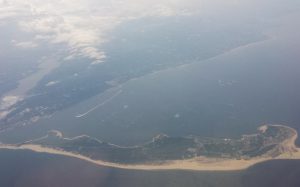
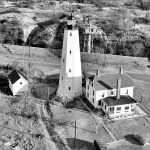 Most of us have heard the name Sandy Hook because of the school shooting that took place in an elementary school with the same name in Newtown, Connecticut. That tragedy was not the first time the name Sandy Hook had been at the center of attention, however. Most people know that along United States coastal areas, there are many lighthouses. The lighthouses might not be so necessary these days, because of GPS tracking, but before all of the technology that we have today, lighthouses were the only way for a ship to know if they were coming dangerously close to a stretch of land. Such was the case with the Sandy Hook lighthouse in 1776. The problem they were having with the lighthouse, however, is that it was thought that the lighthouse would also help the British ships to invade New York City. It was a very real concern, and posed a grave danger to the Provincial Congress of New York.
Most of us have heard the name Sandy Hook because of the school shooting that took place in an elementary school with the same name in Newtown, Connecticut. That tragedy was not the first time the name Sandy Hook had been at the center of attention, however. Most people know that along United States coastal areas, there are many lighthouses. The lighthouses might not be so necessary these days, because of GPS tracking, but before all of the technology that we have today, lighthouses were the only way for a ship to know if they were coming dangerously close to a stretch of land. Such was the case with the Sandy Hook lighthouse in 1776. The problem they were having with the lighthouse, however, is that it was thought that the lighthouse would also help the British ships to invade New York City. It was a very real concern, and posed a grave danger to the Provincial Congress of New York.
The Sandy Hook lighthouse was located on a piece of land that was disputed territory in those days. The land sits directly across the bay from New York City, making it an important shipping lane, but a dangerous one too. In early 1761, the Provincial Congress of New York set up lotteries to raise money for the construction of a lighthouse. A lighthouse in this area had been under discussion for nearly a century before it was initiated by Colonial Governor Edmund Andread. Forty three New York merchants proposed the lotteries to the Provincial Council, after losing 20,000 sterling pounds to shipwrecks in 1761. The money was collected, and the Sandy Hook lighthouse was built. It first shone its beam on June 11, 1764. It served it’s purpose quite well…in fact maybe too well…at least during the Revolutionary War. Ships weren’t sinking, but in a big way, it left New York City quite vulnerable to attack. So, after just fifteen years of use, the New York Provincial Congress decided that the lighthouse had to be dismantled. Then came the controversy. A committee of the New York Provincial Congress told Major William Malcolm to “use your best discretion to render the light-house entirely useless.” They wanted him to remove the lens and lamps so that the lighthouse could no longer warn ships of possible hazards on the rocky shore. He succeeded. Colonel George Taylor reported to the committee six days later, that Malcolm had given him eight copper lamps, two tackle falls and blocks, three casks, and a part of a cast of oil from the dismantling of the beacon.
Malcolm’s efforts failed, because the lighthouse was quickly put back into service by the merchants in the area, with the installation of lamps and reflectors. The Patriots attempted to knock the light out again on June 1st, by placing cannon on boats and attempting to blow away the British paraphernalia, damaging some of it before 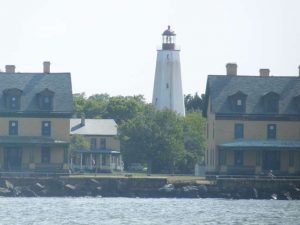
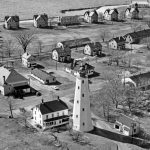 they were chased away. Malcolm’s efforts did not prevent the British from invading New York City. The new states of New York and New Jersey fought over ownership of the lighthouse until the federal government assumed control of all US lighthouses in 1787. As of 1996, the Sandy Hook lighthouse, the oldest original lighthouse in the United States, became a historic landmark, and passed into the jurisdiction of the National Park Service. It is still in operation as part of the Gateway National Recreation Area.
they were chased away. Malcolm’s efforts did not prevent the British from invading New York City. The new states of New York and New Jersey fought over ownership of the lighthouse until the federal government assumed control of all US lighthouses in 1787. As of 1996, the Sandy Hook lighthouse, the oldest original lighthouse in the United States, became a historic landmark, and passed into the jurisdiction of the National Park Service. It is still in operation as part of the Gateway National Recreation Area.
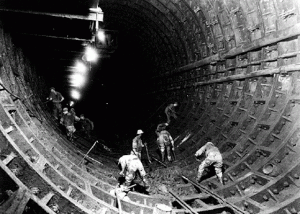 Living in New Jersey, does not necessarily mean that people work or shop in New Jersey. Since Manhattan is just across the Hudson River, many people work and shop there…who wouldn’t, given the chance. I suppose that at some point it was decided that there might soon be too many bridges over the river, and maybe a tunnel under it could be built. The first known underwater tunnel to be built was the Thames Tunnel, built beneath the River Thames in London, connecting Rotherhithe and Wapping. It was built between 1825 and 1843 using Marc Isambard Brunel’s and Thomas Cochrane’s newly invented tunneling shield technology, by Brunel and his son Isambard Kingdom Brunel. So the idea was not new, and in fact, not even new to New York City. The Port Authority had acquired the Holland Tunnel in 1930, and soon after New York and New Jersey authorized the agency to proceed with its plan to build what was then called the Midtown Hudson Tunnel or the Midtown Vehicular Tunnel. Creating a 1.5-mile-long structure, even above ground, would be no small accomplishment, but to build it under a riverbed was a monumental task. Hundreds of huge iron rings, each weighing 21 tons, had to be assembled and bolstered together on site to form the lining of the tunnel. At some point it was decided that Midtown Vehicular Tunnel was not grand enough…so in the spirit of patriotism they named it the Lincoln Tunnel, because of the George Washington Bridge. On this day, December 22, 1937 the 8,216 foot center tube opened in 1937, followed by the 7,482 foot north tube in 1945. The 8,006 foot south tube was the last to open, in 1957.
Living in New Jersey, does not necessarily mean that people work or shop in New Jersey. Since Manhattan is just across the Hudson River, many people work and shop there…who wouldn’t, given the chance. I suppose that at some point it was decided that there might soon be too many bridges over the river, and maybe a tunnel under it could be built. The first known underwater tunnel to be built was the Thames Tunnel, built beneath the River Thames in London, connecting Rotherhithe and Wapping. It was built between 1825 and 1843 using Marc Isambard Brunel’s and Thomas Cochrane’s newly invented tunneling shield technology, by Brunel and his son Isambard Kingdom Brunel. So the idea was not new, and in fact, not even new to New York City. The Port Authority had acquired the Holland Tunnel in 1930, and soon after New York and New Jersey authorized the agency to proceed with its plan to build what was then called the Midtown Hudson Tunnel or the Midtown Vehicular Tunnel. Creating a 1.5-mile-long structure, even above ground, would be no small accomplishment, but to build it under a riverbed was a monumental task. Hundreds of huge iron rings, each weighing 21 tons, had to be assembled and bolstered together on site to form the lining of the tunnel. At some point it was decided that Midtown Vehicular Tunnel was not grand enough…so in the spirit of patriotism they named it the Lincoln Tunnel, because of the George Washington Bridge. On this day, December 22, 1937 the 8,216 foot center tube opened in 1937, followed by the 7,482 foot north tube in 1945. The 8,006 foot south tube was the last to open, in 1957.
On average, the Lincoln Tunnel sees upwards of 120,000 cars passing through every day. It is one of the busiest roadways in the country. On the afternoon of September 8, 1953, the tunnel became famous when two men, who had attempted to rob a house in South Orange New Jersey were chased away by its residents. Their car’s license plate was relayed to the police. Peter Simon and John Metcalf escaped into the Lincoln Tunnel and were spotted by transit authorities upon entering. A car chase ensued amid the traffic through the tunnel. Police commandeered a delivery truck and fired shots at the getaway car as it swerved around other vehicles. In all 28 shots were fired, and the driver, Peter Simon, was shot in the head about three quarters of the way to the other side of the tunnel. The gunfight was reported by The New York Times the next morning.
The Hudson River current has historically stayed close to the edge of Lower Manhattan, but with the construction of Battery Park City, which juts out into the river, part of the current has been rerouted. Its new location brings it more toward the river’s center and it’s uncovering much of the soil lying on top of the walls and ceiling of the Tunnel. As of 2009, some parts of the tunnel’s walls have seen a soil coverage decrease of about 25%, making them far more susceptible to shifting or cracking in the coming years. Not good!!
The process of building the 1.5 mile tunnel was grueling. To support the cavities that the workers dug out, they  installed a series of 21 ton iron rings set into the walls. The workers who dug the tunnels, called sandhogs, had to use a series of airlocks to depressurize and re-pressurize their bodies while entering a new section of the tunnel. With no ventilation, the air in each pressurized section got stale quickly. The excavation involved digging, lining the walls with the rings, pouring cement into every crease and crack to the keep the water out, and finally they moved along to the next airlock. Clifford Holland, chief engineer and namesake of the Holland Tunnel, died of a heart attack at 41 years of age due to immense stress during the construction, as well as the growing toxicity of the air in the airlocks. The Lincoln Tunnel faired better, with no reported work-related deaths.
installed a series of 21 ton iron rings set into the walls. The workers who dug the tunnels, called sandhogs, had to use a series of airlocks to depressurize and re-pressurize their bodies while entering a new section of the tunnel. With no ventilation, the air in each pressurized section got stale quickly. The excavation involved digging, lining the walls with the rings, pouring cement into every crease and crack to the keep the water out, and finally they moved along to the next airlock. Clifford Holland, chief engineer and namesake of the Holland Tunnel, died of a heart attack at 41 years of age due to immense stress during the construction, as well as the growing toxicity of the air in the airlocks. The Lincoln Tunnel faired better, with no reported work-related deaths.

